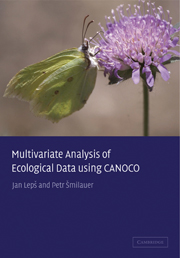Book contents
- Frontmatter
- Contents
- Preface
- 1 Introduction and data manipulation
- 2 Experimental design
- 3 Basics of gradient analysis
- 4 Using the Canoco for Windows 4.5 package
- 5 Constrained ordination and permutation tests
- 6 Similarity measures
- 7 Classification methods
- 8 Regression methods
- 9 Advanced use of ordination
- 10 Visualizing multivariate data
- 11 Case study 1: Variation in forest bird assemblages
- 12 Case study 2: Search for community composition patterns and their environmental correlates: vegetation of spring meadows
- 13 Case study 3: Separating the effects of explanatory variables
- 14 Case study 4: Evaluation of experiments in randomized complete blocks
- 15 Case study 5: Analysis of repeated observations of species composition from a factorial experiment
- 16 Case study 6: Hierarchical analysis of crayfish community variation
- 17 Case study 7: Differentiating two species and their hybrids with discriminant analysis
- Appendix A Sample datasets and projects
- Appendix B Vocabulary
- Appendix C Overview of available software
- References
- Index
5 - Constrained ordination and permutation tests
Published online by Cambridge University Press: 09 February 2010
- Frontmatter
- Contents
- Preface
- 1 Introduction and data manipulation
- 2 Experimental design
- 3 Basics of gradient analysis
- 4 Using the Canoco for Windows 4.5 package
- 5 Constrained ordination and permutation tests
- 6 Similarity measures
- 7 Classification methods
- 8 Regression methods
- 9 Advanced use of ordination
- 10 Visualizing multivariate data
- 11 Case study 1: Variation in forest bird assemblages
- 12 Case study 2: Search for community composition patterns and their environmental correlates: vegetation of spring meadows
- 13 Case study 3: Separating the effects of explanatory variables
- 14 Case study 4: Evaluation of experiments in randomized complete blocks
- 15 Case study 5: Analysis of repeated observations of species composition from a factorial experiment
- 16 Case study 6: Hierarchical analysis of crayfish community variation
- 17 Case study 7: Differentiating two species and their hybrids with discriminant analysis
- Appendix A Sample datasets and projects
- Appendix B Vocabulary
- Appendix C Overview of available software
- References
- Index
Summary
In this chapter, we discuss constrained ordination and related approaches: stepwise selection of a set of explanatory variables, Monte Carlo permutation tests and variance partitioning procedure.
Linear multiple regression model
We start this chapter with a summary of the classical linear regression model, because it is very important for understanding the meaning of almost all aspects of direct gradient analysis.
Figure 5–1 presents a simple linear regression used to model the dependence of the values of a variable Y on the values of a variable X. The figure shows the fitted regression line and also the difference between the true (observed) values of the response variable Y and the fitted values (Ŷ; on the line). The difference between these two values is called the regression residual and is labelled as e in Figure 5–1.
An important feature of all statistical models (including regression models) is that they have two main components. The systematic component describes the variability in the values of the response variable(s) that can be explained by one or more explanatory variables (predictors), using a parameterized function. The simplest function is a linear combination of the explanatory variables, which is the function used by (general) linear regression models. The stochastic component is a term referring to the remaining variability in the values of the response variable, not described by the systematic part of the model. The stochastic component is usually defined using its probabilistic, distributional properties.
We judge the quality of the fitted model by the amount of the response variable's variance that can be described by the systematic component.
- Type
- Chapter
- Information
- Multivariate Analysis of Ecological Data using CANOCO , pp. 60 - 75Publisher: Cambridge University PressPrint publication year: 2003
- 5
- Cited by



